While homeless numbers have dropped over the last few years, Kona visitors and stakeholders say transient behavior is becoming more brazen — changing the town’s atmosphere for the worse
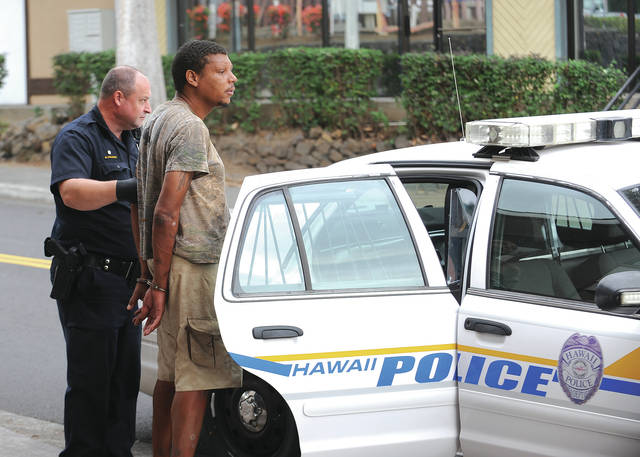
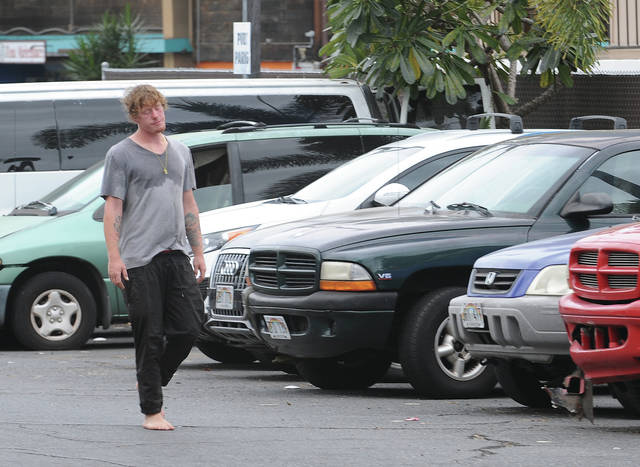
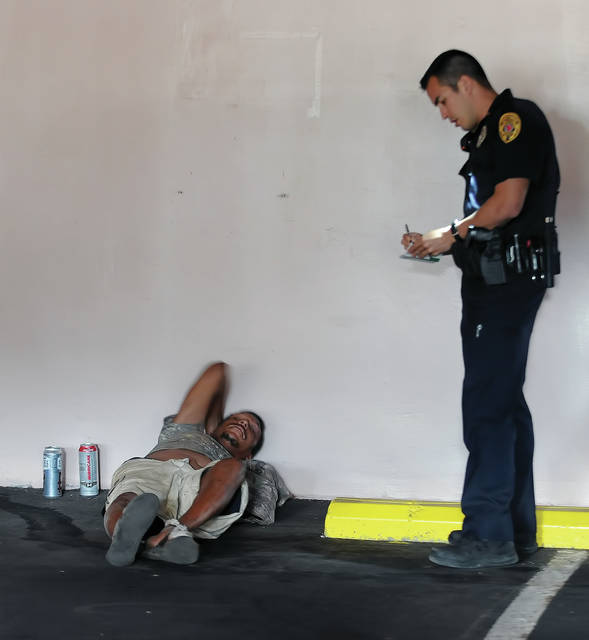
Police Officer Chandler Nacino talks with a homeless man sleeping in a parking garage off Hanama Place. (Laura Ruminski/West Hawaii Today)
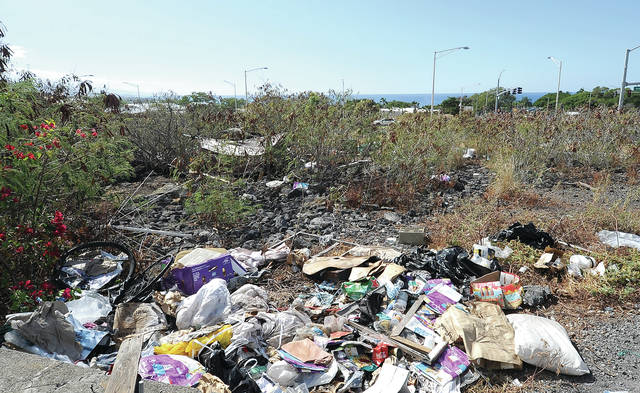
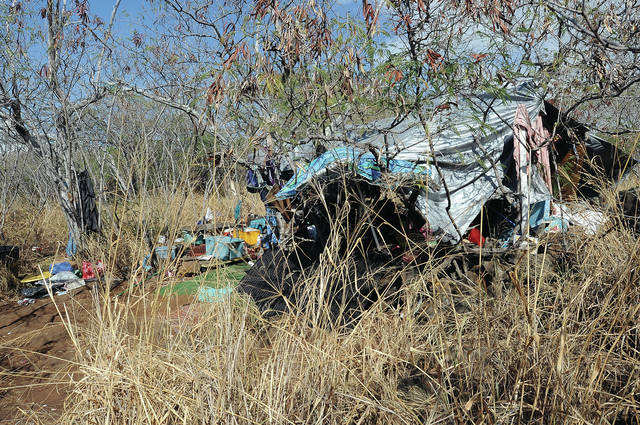
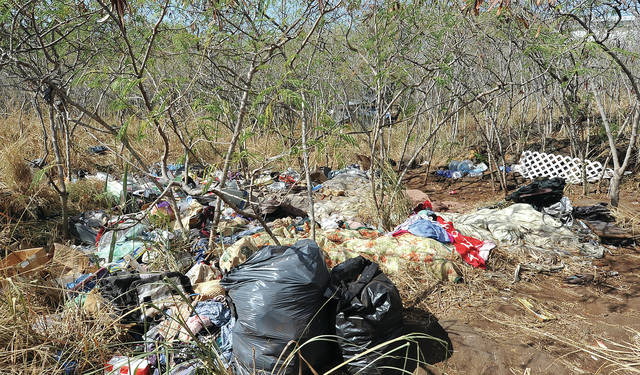
Trash piles up on state land next to the Kailua Fire Station. (Laura Ruminski/West Hawaii Today)
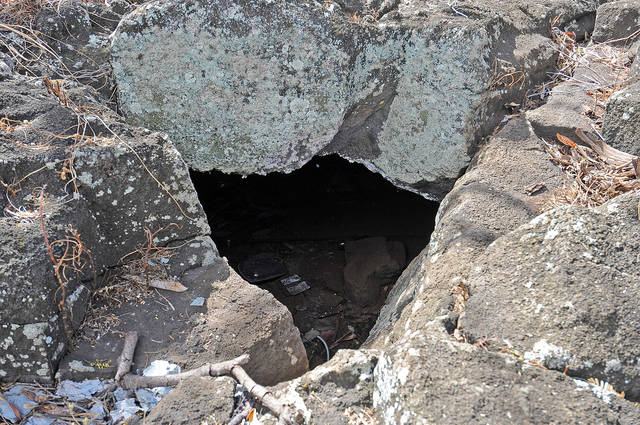
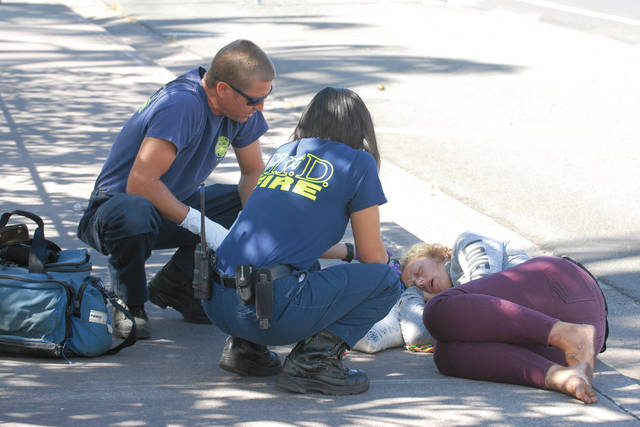
Rescue personnel try to help a homeless woman sleeping on the curb who became belligerent after being roused. (Laura Ruminski/West Hawaii Today)
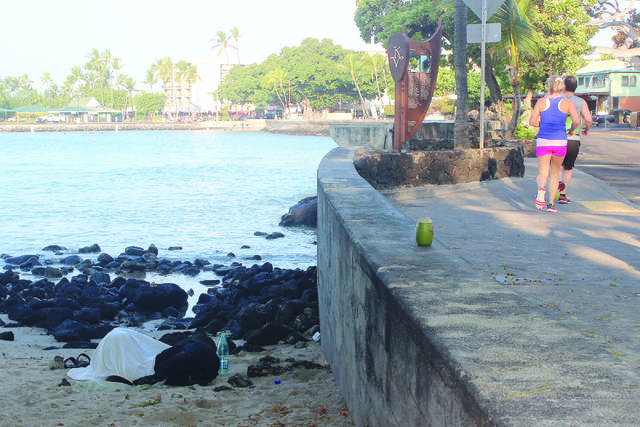
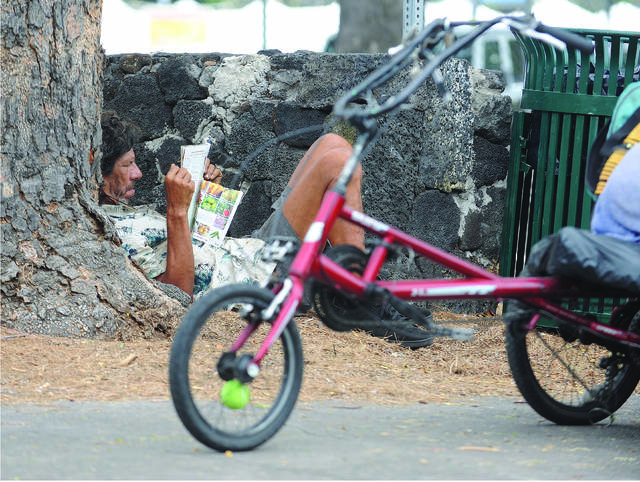
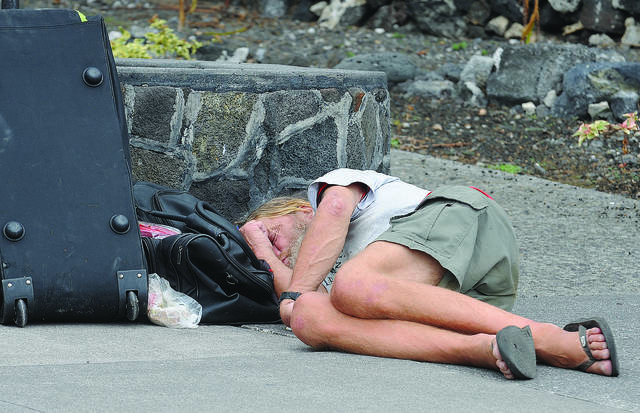
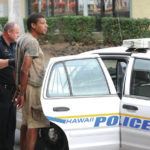

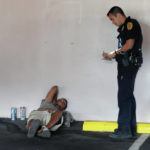
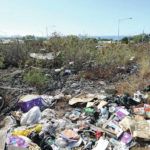


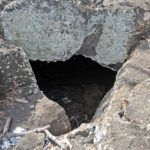
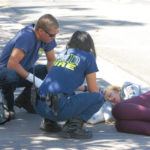
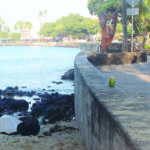
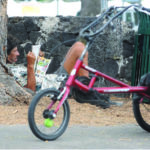
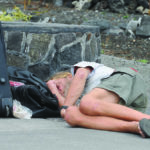
KAILUA-KONA — Emily DuPlessis pushed her child’s stroller down the path from their rented condo to the beach, her two other young children in tow, before nearly tripping over a homeless man stretched out perpendicularly across the pavement.
KAILUA-KONA — Emily DuPlessis pushed her child’s stroller down the path from their rented condo to the beach, her two other young children in tow, before nearly tripping over a homeless man stretched out perpendicularly across the pavement.
Politely, she asked him to move. Impolitely, he asked of her compensation for the trouble. She declined. Laying back down, he declined as well.
“Your downtown district is saturated with transient people who are unsettlingly confident,” the Washington-based educator wrote of Kona in a December letter to the editor emailed to West Hawaii Today. “They stroll the streets high on drugs and distract tourists for money and attention. … This is not a family vacation environment.”
DuPlessis cited the aggressive and unsavory behavior she encountered from area homeless as the sole reason she felt concern for her family’s safety and as the catalyst behind a firm choice never to return.
WHT published the letter to vociferous response. Some took umbrage, defending their hometown or a place they’d enjoyed a pleasurable getaway.
However, the majority of commenters took up her lament regarding the deterioration of the village due to general homeless presence, particularly in the areas of Alii Drive, Kuakini Highway and the Old Kona Industrial Area.
Yet a disconnect exists here at the intersection between the anecdotal and statistical.
The seemingly overwhelming public sentiment that homeless behavior is growing more brazen and disruptive in Kona is at odds with numbers produced by county and state surveys over the last two years.
State Point-In-Time Count tallies, which are conducted by volunteers, self-reported by the homeless and not regarded by any authority as entirely accurate, have nevertheless registered a nearly 38 percent drop in the homeless population across Hawaii County between the years 2016-2018.
Regardless of flaws, no margin of error could span such a statistical chasm. And every PIT Count prior was conducted in the same fashion, with the same flaws. The homeless population has decreased. It is a certainty.
Yet residents and visitors alike who spoke to the paper agreed unanimously that homeless presence is felt across West Hawaii more strongly now than ever.
The relevant question — why?
A possible answer — most of the problems posed by the homeless population are caused by a handful of individuals, men and women uninterested in life off the streets, people whom no housing project or outreach program can entice.
Hawaii and Hawaii County have thrown time, personnel and financial resources at the issue, doing so at unprecedented rates over the last three years. And the results are there. Nearly a fifth of the state’s homeless have been housed since rock bottom. Newly re-elected Gov. David Ige stood on the issue Tuesday as he delivered his annual State of the State Address.
But what is to be done about those who refuse help, many of whom are the most disruptive and criminal, as well as the ones driving public perception that nothing about homelessness has improved when regarded against the day-to-day quality of life for locals and tourists?
No authority has yet found an answer. But there has been plenty of community reaction and reflection.
“I’m not proud of my town,” said Nakoa Pabre, owner of Umeke’s Fishmarket Bar and Grill, which is located on the corner of Kuakini Highway and Kaiwi Street. “I want to be. We’ve got to come together as a community and step up and take our town back.”
INTENSE ENCOUNTERS
Part of the disconnect may involve an order handed down by Mayor Harry Kim in the summer of 2017, in which he mandated all illegally squatting residents of Old Airport Park be removed and relocated.
That year, the PIT Count documented953 homeless across the island, down from an all-time high of 1,394 in 2016. Several dozen West Hawaii homeless lived in tents or other handmade shelters across the area. Despite efforts to set up a temporary campsite known as Camp Kikaha in the Old Industrial Area and house as many as possible, there was spillover into the community.
Businesses noticed it then. And they continue to notice it now, as homeless yet congregate and camp illegally outside the HOPE Services Hawaii campus on Pawai Place — where Camp Kikaha was born and where it died several months ago.
“I believe the homeless presence has increased,” Pabre said. “They’re not respecting the land. They don’t give a (expletive). They treat this land like it’s their trashcan and it breaks my heart.”
Pabre, who plans to move Umeke’s to a site even closer to HOPE, picks up garbage out of his parking lot regularly. He witnesses homeless mainstays lighting up “ice,” also known as crystal methamphetamine, in broad daylight. One morning around 5 a.m., he arrived to work to find what he described as “prostitution” in motion on his front steps.
It wasn’t the first time.
Benjamin Vasquez, who visited the island from California, said a homeless man on Alii Drive began nonsensically berating his girlfriend Amanda when she told the man she had no cash to give him.
“If I hadn’t been there, I don’t know what would have happened,” Vasquez said.
He added Amanda was visibly shaken for a few hours, though she calmed down later. They planned to spend most of their remaining time at points either north or south of Kona. Vasquez was unsure if they would ever return.
“Maybe,” he said. “I just don’t know, man.”
Stefanie Gubser, operations manager for Manini Holdings LLC, which owns 6 acres in the Old Industrial Area and is developing the site for Kona Brewing Company’s new facility, said the cost of property damage caused by homeless has already climbed into the thousands since she moved over to the job just a few months ago.
Homeless rip out irrigation systems, tear through electrical setups, cut fences, she said.
“I’m in it every day,” Gubser added. “It’s in my face every day.”
She’s not alone.
Joe Pereira, of Hawaii Island Lawns LLC, works properties throughout the zones of Kona popular with homeless. He said most vandalism originates in efforts to obtain power, water and to put out lights.
He’s seen homeless unscrew light bulbs or sling rocks if the light source is out of reach. He said they damage covers and locks on power outlets or break into locked recyclable containers like those at Keauhou Shopping Center and Kona Commons to retrieve $10-$15 in returnable materials.
“They’ll go and bust up an irrigation system to turn it on and take a shower,” Pereira said.
Bob Dixson, owner of the Dixson 76 Station on the corner of Kuakini Highway and Hualalai Road, believes as Pabre does that homeless presence has steadily increased — and not just over the last two years, but across the entirety of the nearly two decades he’s run his business there.
“I always need to pay special attention to (my public bathrooms) because they get soiled more than they should be,” he said. “I see signs of drug use. It’s not that uncommon for me to walk in there and see a syringe or whatever.”
And the filth spills out of the bathroom into the parking lot if Dixson isn’t there to police it.
“I’ve seen people defecating out there in the corner,” he said. “Eighteen years later, and I still see the same stuff.”
IMPACTING TOURISM?
The parks themselves, particularly Old Airport Park, have not become exempt from homeless influence since Mayor Kim issued the enforcement mandate.
Maurice Messina, deputy director of Parks and Recreation in Hawaii County, said the homeless population is beginning again to swell in the brush surrounding the ball fields at Kona’s north end.
In an interview after her letter was published, DuPlessis noted when her family visited the beach at Old Airport to take photos, her daughter stepped in a pile of human excrement as homeless mulled about.
“She was crying,” DuPlessis recalled. “We cleaned up her shoes and we tried to calm her down.”
What impact incidents like the one DuPlessis described have had on tourism is difficult to say.
Visitor and spending numbers have dipped everywhere on the Big Island since Kilauea’s fury began in May and have yet to show signs of significant recovery as of December.
With no specific data tracking the correlation between incidents involving homelessness and lower visitor rates, it’s impossible to know definitively what kind of lasting impact the issue has imposed upon the state’s most lucrative industry.
The Hawaii Tourism Authority publishes statewide data via surveys included in its annual Visitor Satisfaction and Activity Report. The reports take time to compile and 2017’s was yet to be published when this story went to print.
But in 2016, the most recent year data was available, there were a percentage of those surveyed who said homelessness had a negative impact on their time in Hawaii.
That year, when homelessness was at its peak in Hawaii, a state with a higher per capita percentage of that population than any other, homeless presence resonated most significantly with visitors from the East Coast of the U.S. as 2.9 percent hailing from that region said it impacted their visits negatively.
Tourists from China and Korea didn’t mention issues with homeless at all, while 2.6 percent of Canadians, 1.8 percent of visitors from the West Coast of the U.S., 1.5 percent of visitors from Japan, 0.7 percent of visitors from Europe and 0.6 percent of visitors from Oceania noted problems with homeless that detracted from their experience.
HTA’s survey question was such that each person questioned could only respond with one answer. The title of the data sheet accessible via the HTA website is titled “One Experience that Posed a Negative Impact to Your Stay in Hawaii.”
Thus, there is a high probability that greater percentages of visitor populations experienced homelessness in Hawaii negatively than listed above. Those numbers instead represent the portions of tourists with whom homelessness was the most significant detractor from their stays.
For a long time prior to 2018, tourism numbers hit all-time records year after year, and were set to expand considerably again on Hawaii Island before the lava started flowing at Kilauea in May.
Every year since 2010, with the exception of 2017, homelessness numbers rose along with visitation and spending.
By themselves, those figures are not sufficient evidence to support the notion that homelessness hasn’t affected the tourism industry. Issues involving homeless could have discouraged return visits even while the popularity of tropical vacations and the successes of county and state tourism initiatives sent overall numbers soaring.
According to HTA’s 2016 report, visitors from these same geographical categories were asked how likely they would be to make a return visit to Hawaii inside of five years. Responses of “not likely at all” ranged between 1.1 percent (U.S. West and Korea) to 5.1 percent (Europe).
The two most important markets to Hawaii tourism, the U.S. overall and Japan, recorded 1.7 percent and 1.6 percent of “not likely at all” to return responses, respectively. No data was included on the reasons why those surveyed responded as they did.
Beyond what can be drawn from limited statistics, anecdotal evidence remains the only real gauge, however inexact, to measure the correlation between homeless presence and tourist satisfaction/likelihood of return.
Kirstin Kahaloa, former executive director of the Kona-Kohala Chamber of Commerce, said in past interviews with West Hawaii Today that the chamber received several calls about homeless concerns from businesses and tourists alike during her time there in 2016 and 2017.
Wendy Laros, current executive director, said the chamber isn’t ready to go on record with public feedback it’s received in recent months but that homelessness is an issue on the chamber’s radar.
For several years, the Kailua Village Improvement District has listed homelessness as one of its top priorities.
EXPLORING SOLUTIONS
Neither Pabre nor Dixson were amenable to the idea of relocating to escape the hardships of doing business alongside homeless neighbors.
“I’m not gonna move,” Pabre said. “Move them.”
Hawaii County is pushing forward with Village 9, which will be an emergency homeless site before transforming into a permanent, 15-acre location complete with social services and the capacity to house dozens, if not hundreds, of homeless.
The 5-acre emergency site may be ready for occupants as early as May, but incentivizing homeless to reside there may prove a precarious proposition. Village 9’s location off Kealakehe Parkway is several miles from the heart of Kona and reliable transportation back and forth may not be immediately available.
Even if the county can convince the lion’s share of its West Hawaii homeless individuals to reside up mauka, it may only reduce the number of bodies in the streets, not the seemingly aggressive and sometimes criminal behaviors that originate with a small segment of the population responsible for most of the trouble.
“I’d say we don’t deal with that many of them,” explained Sgt. Joseph Stender Jr., with the Hawaii Police Department’s Community Policing Division. “The total number compared to how many we actually interact with that are violating laws, the number is fairly small.”
Of that group, many are committing only petty crimes like trespassing, minor theft or public indecency. Various police spokespeople have said on several occasions that homeless often end up back on the streets after only a few nights inside a cell because of that.
Gubser said her experience in the Old Industrial Area mirrors Stender’s description of the scene there and in other area popular with homeless. Manini Holdings has taken names in attempts to track troublemakers, and Gubser believes it’s as few as 10-20 individuals behind essentially all the criminal activity perpetrated in and around Brewery Block.
The nature of the homeless she and Stender referred to, as well as their relatively small numbers and transient tendencies to move from place to place, also render precarious Dixson’s suggestion of more community outreach as a solution to intensifying aggressiveness.
“That portion of the population, a lot of them don’t really want the help that is out there,” Stender said.
In the same spirit of Pabre’s sentiment that the community needs to “rise up” against homeless misbehavior, Gubser explained that property managers across the Old Industrial Area are banding together in what she called the Pawai Place Security Hui to share information. They also plan to hire the same security firm to consolidate efforts toward controlling the population.
Asked if she felt homeless people had become more aggressive and brazen over recent months and years, a homeless woman named Roni who has lived on the island her entire life — though not all of it as a homeless person — said she didn’t believe that was the case.
“There’s always been a few rough,” Roni said. “People just starting to notice more.”
A homeless man, who asked to be identified only as Mike, sat near the edge of the seawall on Alii Drive early last week. He was asked if he’d be willing to relocate to Village 9 for the promise of permanent shelter if it meant he wouldn’t always have readily available transport to regular Kona hangouts.
“Depends,” he said, as he lay back on the wall. “But I don’t think so.”
When asked if his decision would be influenced by knowledge that the county planned to create a drug treatment center on site at the homeless camp, Mike responded with only a brief scoff of laughter.
A SPRAWLING PROBLEM
As of last week, there were 664 single individuals in Hawaii County registered in the Homeless Management Information System, according to numbers provided by Brandee Menino, CEO of HOPE Services. Only 113 of them had expressed interest in permanent housing to that point.
The rest need to be somewhere. When the county took away Old Airport Park and intensified early morning beach sweeps, the homeless ranks at established camps like the one above the intersection of Palani Road and Queen Kaahumanu Highway near the Kailua Fire Station began to grow.
Located on state land, the county has not been given clearance to evacuate and dismantle the camp.
Capt. Sean Sommers, who works for the Hawaii Fire Department at the Kailua Fire Station, said even a few of his men are uncomfortable with the swelling homeless presence just outside their door, not to mention the easy access into their place of business where firefighters frequently spend the night.
Perhaps nowhere has the brazen quality of homeless behavior been more glaring than in the examples Sommers, a county-employed authority figure, has encountered at his station.
“I was actually in my dorm room getting ready to go to sleep, and I noticed a reflection in the room,” he said. “I turned around and there was a (homeless) woman who’d just helped herself in. … Without an emergency, it’s basically the same thing as walking into someone’s house.”
It wasn’t the first time Sommers has been roused in the early morning hours to a homeless presence in the fire station. He said that while there have been reports of theft in the past, the homeless he’s encountered in the station are typically wandering around “out of it” either because of mental illness or drugs.
Sommers added that HFD does what it can to address the issues posed by the camp but budgetary restrictions leave solutions limited.
“The big city stuff is starting to come around,” Sommers said.
A lack of public funding and lack of willingness on the part of some homeless to cooperate have been central to a feeling among several residents, visitors and county officials that while stats indicate homeless numbers are on the decline, the day-to-day impact of homeless presence in West Hawaii may well be increasing in both frequency and aggressiveness.
Most of the problems often revolve around only a handful of instigators and recidivists within the population, but no one has yet figured out how to reach them.
In the meantime, aggression builds within their ranks as aggravation, exhaustion and despondence builds within the community — evident in the shocking stories told and disappointing conversations held.
“It’s not the same place,” Pabre said of his hometown. “My kids will never know what it used to be.”



Well, there’s your solution, if these people won’t accept a place to live, we’ll provide one involunatarily. It’s called jail, because the last time I looked, smoking meth, engaging in public sex acts, stealing and destroying property are all crimes. More police presence and less social justice warriors might reduce the public presence of these burdens.
Fairly obvious the cops are being told to stand down.
Now, which political persuasion would call for that?
Cops take their direction from the Chief and Deputy. Political influence goes through those two.
Are you saying that the Hawaii cops are seeing crimes but, because they have been “told to stand down,” they are ignoring those crimes, numbah10? What evidence do you have of this because that is a pretty substantial allegation; that a cop is deliberately ignoring his oath under orders from a superior? I’m not going to get into the “political persuasion” part of your comment unless you want to but I think you owe us an explanation regarding what you wrote about the island cops.
Police standing down for petty crimes is happening all over the country. Set up a detention center like Joe Arpio did in Phoenix. Enforce vagrancy laws if they are still on the books. Just keep picking them up until they agree to take a mainland ticket. Then give it to them.
Again, John, like I asked numbah10 and Scooby….you are saying that cops have been ordered by superiors to ignore crimes that they witness? I ask you then, what evidence do you have of this? The Kona cops have had ethical problems in the past and, if you know that they are ignoring crimes on orders from above, you need to report this immediately to the state cops or Governor’s office. Otherwise, how will you stop it?
You need to go to the mainland. Vagrancy is rampant. Mostly in blue states. People living on the streets. One time used to be arrested for that behavior. Not now. Grafetti all over the place. You gonna tell me some grafetti that took hours to do wasn’t noticed. We need work camps for these people. Get them off their asses and pay them minimum wages at shelters. Get them off the streets for the good of the community.
I meant what I wrote sport, stop trying to rewrite things to suit yourself.
Lack of police presence that many have noticed, is defacto standing down. They damn sure know what is going on, but choose to be elsewhere or have been directed to do that.
But your original statement, which I merely asked you to explain, was that “the cops are BEING TOLD to stand down.” Now it’s a “de facto standing down.” Of course the cops know what’s going on, they bust people on Alii Drive every day. They patrol Alii Drive every day. But, unless you have a cop following every homeless criminal, the criminal will figure out how to commit a crime. You seem to think the cops don’t want to fix this for some reason. I think you are just biased against cops, government, society in general, numbah. Nothing wrong with that.
The police have to catch people in the act of committing a crime or have evidence afterwards to link someone to it. “More police presence” costs more money? Any ideas on where that should come from? I think jailing criminals is great but tell me how we catch them all?
It’s money alright, lost money, if we don’t protect little girls from stepping in human waste, tourist dollars. There is only one solution, an enhanced 24 hour police presence, so they can witness crimes as they occur. Surveillance cameras blanketing the area would be a big help.
Where do we find the money? Considering the dollars flushed down the toilet by this county (when water is available), that should be easy, but it’s not going to happen, is it? Because even if the downtown merchants paid for the patrols, the liberals in government wouldn’t allow that kind of crackdown. So nothing really will be done at all.
How bad can it get? Drive the Waianae coast of Oahu sometime. Lock your doors and do not stop. It’s unbelievable.
So, you have no solutions or ideas other than to totally ostracize people you find objectionable?
One must make choices. You either put up with madmen and criminals, or you deal with them forcefully in order to preserve decent society.
Those causing the problems are not the “disadvantaged”, people who found themselves on the outside of luck and needed help to right their lives. No, these are people who defy authority and spit on help, who choose to live as criminals and bums. We shouldn’t allow them to run amok, but . . . we will.
The county had better get serious about enforcing laws on vagrancy and illegal encampments like the one by the fire station or the numbers will grow. The parts of the country where the basic laws are enforced don’t see the number of homeless grow. If we continue to ignore the violations it will only get worse and be harder to deal with later.
Are there “vagrancy” “laws” on the island? And what violations are being ignored? Just because people see people do things doesn’t mean the cops are ignoring them does it? Have you seen an island cop deliberately ignore investigation of a crime he/she witnessed or had reported to them? Recently?
A relatively easy solution would be to create a temporary jail at the same Village 9. If the druggies and drunks don’t want to go there voluntarily, then they are sent there just like they would to jail. The services will be there. Only difference is they are sentenced and have to remain there for the duration. No TV, pets, drinks and no drugs. Quit coddling them and make them take some responsibility. No need to listen to the ACLU. They can give them a ribbon when they are released.
I agree but some of these people have mental health problems that need to be addressed. Help them get of the dope and try to fix the mental problems so these people can re-enter polite society and you’ll see this problem get much smaller. I would pay a bit more in taxes if they would fix this problem but I don’t trust the county government enough.
Stop being nice to people with no intention of helping themselves or showing any respect to you or anybody else. Being a crackhead isn’t a mental health issue. And if they are crazy, put them in an institution. Guaranz you will now say that’s not fair!
Ronald Reagan closed all of the “institutions,” Chickie. They cost too much to run.
$1300 a day per person at Oregon State Hospital. They do a good job, but it is a revolving door.
Contrare Mon Frair,
It was Jerry Moonbeam Brown’s father that closed them in California in 1959. the ACLU sued during Reagan’s administration to make it a Federal law. The ACLU said that people that are not harmful to others can make the decision on their own institutionalization.
Sorry! Nice try though and no, I don’t speak french so don’t cry about the spelling.
Only in California. Now you know why the state is so, you know…
Which institution would you “put them in”? No such place exists in Hawaii. HSH closed its doors to all but forensics long ago.
Send to state that issued their “social security numberrrrrrrr”.
Ok, enough of you two now. Nite Nite comrades.
Druggies and drunks already have a jail, Michael. It’s run by the government and it’s been there since there have been cops. Are you saying that anyone caught using drugs or getting drunk has to go to the Village 9 jail? Will we have teams of people going through bars doing breath tests on people with vans sitting outside to haul off? Because if you really are after “druggies and drunks” you gotta realize how many of THEM there are on the island. Most of THEM are not homeless either.
Jim, that jail typically lets those homeless people out as there are not enough beds for them. A temp jail at Village 9 could serve those homeless drunks and druggies (ones that will not volunteer to go to the shelter) and provide services. It simply is not their choice to do whatever they want at others costs. And while the other drunks and druggies are a massive problem, most aren’t homeless and they can be served at our local jail. The issue is dealing with these homeless drunks and druggies not society in general.
So you think that society spends more on homeless druggies and drunks than we do in lost productivity, insurance rates, cleaning up after drunk drivers wipe out families, prescription opioids, etc., Michael?
You can’t win Michael, Jim and his bunch are the obstructionist that keep these problems from being fixed( . Y . )
as usual..the local government dosent have the guts to deal with this…so what if homeless…your like any other citizen…but get in someones face..be an asshole…then you deserve to get your ass kicked..some of these storys I have read..well…I never start a problem..but if some homeless phyco does then stand bye…aloha
According to the article, and what I see on a regular basis, are people breaking the law. The answer to that is having the police aggressively enforce the law. Assign police officers to walking in the village and arresting people who are breaking the law. Another option would be to have a police bicycle patrol in the village.
Not enough police manpower to do that.
No, too busy hassling the regular people for nothing.
Someone who is homeless is not a “regular” person, Chickie? Define irregular for us, please.
I think she means “they” are poor and sick.
No, they are druggies or social deviants for the most part, veterans and the real crazies aside. You guys Antifa?
If you can’t figure that one out, I digress.
Great idea, TaroGuy. Now let’s calculate how many more cops it would take to do that and then how much more tax revenue would have to be collected to pull it off. How much more in taxes would YOU be willing to pay to get it done?
It probably wouldn’t take as many as you think a squad assigned to the Alli St tourist area. If you need more enforcement because the problem has been ignored so long then it is what it is sometime you have to pay. Question is why has it been allowed to get this bad. Jim as far as officers ignoring crimes they see its hard to see crimes when you arent where they are occurring. like i said 4 days walking up and down Alii Dr for several hrs a day bc i couldnt rent a car bc they were out. I was contacted a few times by a few homeless people. They were not over aggressive. I was actually surprised they even approached me given my appearance. I had a conversation with a few of them. One white guy and one black guy. They said they were were there are due to their addiction to drugs. I told them if they were hungry I would get them something to eat but I wouldn’t give them money bc they would most likely use it for drugs. One accepted the offer of food the other declined it. Addiction is a terrible thing and it affects people in all socioeconomic classes some obviously more than others. Its harder to have pity when its not an addiction to opiate use that was no fault of their own.
An Anti vagrancy committee funded by the businesses most impacted might work if they were given quasi police power of some kind. Government itself has proven ineffective.
Great idea, Ghost. Since they are all busy running their businesses and personal lives, why don’t you get started on organizing that and give them all a call when there is something for them to do.
Brown shirts.
Nope you and your Antifa friends are the closest thing to brown shirts. But maybe you mean that you rolled in the mud in the 60s?
I would never recommend that anyone stays in downtown Kona, no matter how cheap the condo is. Resorts or bust on this island.
Eight years running vacationing right in the midst of Kaulua on Alii Drive and we have had absolutely zero problems with the homeless. We see them all of the time but have never had a problem. We even have nicknames for some of them. One thing people forget is that some of those guys are US armed forces veterans who have been messed up for any number of reasons. When was the last time any of you in here walked by one of THEM and said, “Thank you for your service?”
Thank you, sir. They are far better than many who damn them. I know this as psychiatric nurse practitioner who has had the honor of serving more than a few West Hawaii veterans.
We rarely go to restaurants now in downtown. It’s a shame
If most of the problem is caused by a handful of the homeless those are they ones to address. First the prosecutor should obtain restraining orders to keep them away from these areas. It was used in California against drug dealers and gangs. It is legal and effective.
We pay tremendously for our police and prosecutors but they aren’t being effective and should be held accountable. The police say we don’t have the tools well only because the prosecutor office can’t or won’t fix it. Top dollar lazy results
Over the past two years we’ve lived here and going into downtown Kona at night we have never encountered an agressive homeless person, smoking pot yes, but not much else. yes they are there hanging out or trying to get a few hours sleep, but in my experience the majority of people without homes want to not be seen. I find if you treat someone with respect they will not bother you. More mental health care, more day shelters for people to have somehwere to go
B.S.
Chickie Galore has trouble with that “treat someone with respect” thing, Ellen.
I think she is a bot.
Yep. Russian to the core…wait for it! MAGA!!!!
You must be academics from another state…yes?
That’s right. We are just mean people that work and pay for crackheads to exist! Comrades Jim and Liz!
Thank you for proving me right Chickie. You know, you might live ON an island but you don’t have to BE one. Homelessness and drug addiction are not unique to Hawaii. The tragedies in many of these people’s lives and the strength some of them have had to display to get to the point where they are so offensive to you would embarrass you if you cared about anyone you see as lower than yourself. Kind of sad when you hear it put that way isn’t it?
Finally, a sane voice.
Round them all up, stick them on a plane and ship them across the Pacific to California..the ‘sanctuary state’. Our government is unwilling and incapable of dealing with it. When our visitors are being accosted by these dregs of society and their tourist dollars stop flowing in, maybe the damn state will get serious about it. Ige has no clue how to fix it…
I see tourists always staring at the Southeast corner of Queen K and Pilani when I drive through that area. I feel that is an area that needs a fence that either keeps the homeless out of that area or keeps it out of sight. It’s a shame that we have to spend more tax dollars on people that don’t want help that is available for them to get out of their rut. I know, some of these people are probably mentally ill but most are dopers.
What “help” would that be, sir?
The homeless must be FORCED into shelters. We used to have insane asylums for them but we closed them and now we all pay the price.
Okay, guido….for the sake of discussion….”we all pay the price” for closing insane asylums is something I can’t argue with. But, can you argue with the fact that the insane asylums were closed by Ronald Reagan and other conservatives because they were too costly for government to run? So, how do we put these “insane” homeless you see in asylums that won’t cost anyone anything? Can you give me your ideas on this please? Thanks.
Guido….where are you? You haven’t told us how you are going to pay for the upkeep on millions of homeless people or the construction of all of the shelters you propose to build.
Pass a law against pan handling would be a good start. I live in AZ where the weather is nice so as a result we have a large homeless population. Once the cadre of idiots lobbied against it and got it removed everything to worse. Now all we can do is trespass them from private property and they move to public property. In HI not sure if they have restrictions on hours for public parks beaches etc if they dont they may want to look into it. I was just in Kona and I am purchasing a house on Alii Dr and the homeless population is noticeable. There was a large group in the gulley by the shopping center. So something needs to be done. I also found it odd that I didnt see any police officers on Alii Dr the entire 4 days I was there. In Maricopa county cops are everywhere and increased presence in the area from 0 to something may make a difference.
So, if someone panhandles and a cop sees it, they get arrested, Antonio? What if someone panhandles you and there is no cop around? Do you take them down and hold them while you call the cops? Or do you increase taxes and hire undercover cops to wander around until they make their first arrest and are ID’ed then put him/her in uniform and hire another undercover cop? Or do we simply pass a law that forces every citizen to take training so they can arrest people when they see a crime? Just wondering if you have anything constructive to add to the discussion.
He buys another house on Alli drive. I don’t think Maricopa County’s police force is a model for island our LEOs. Weren’t they under federal investigation for abuses?
You assume I am talking about MCSO interesting since there are idk more than 30 other agencies in the county. I guess you get your facts from the news and not from actual research. But as far as MCSO is concerned yes they are on federal probation due to issues that took place when sheriff joe was in charge. I did not care for him either but he is one man and does not represent all law enforcement in AZ. If a woman named Elizabeth committed a crime should we treat all named Elizabeth as a criminal. I think not
Oh and fyi they didnt get on super secret probation for brutality it was for profiling get your facts straight
Jim it its obvious to my you are not in law enforcement so I will try to enlighten you on how it works. If there was a police presence in the area in the first place most of what is going on would decrease rapidly. Do you think these individuals would partake in this unwanted/illegal activity if there was the chance they may actually get arrested. For most it would matter for some it would not. As far as your comments about private citizens doing the police job. Well if you actually had cops policing the area citizens wouldnt need to now would they. As far as cost you have to take a look at how the dept allocates their resources. Come to a place where there is a large amount of tourists in AZ and see how many police officers they have assigned to the area. As far as your undercover comment it would work but not really necessary. Just so you know its not that hard to change your appearance enough to fool someone. The larger question is why isnt anyone doing anything about it? Sounds like that question needs to be put to the politicians responsible for that area. Based upon what I a comprehensive plan would need to be implemented. Some of the homeless I saw had obvious mental health issues so arresting those individuals is a self defeating enterprise. Based on what I saw ICE has a hold of alot of them so maybe expanding their VICE/Narcotics unit if they have one would be a good place to allocate more resources.
One thing I DO know about law enforcement, Antonio, is that if there is polce presence in an area the criminals will go somewhere else and do their crimes. You could hire enough cops to guard every building but one anywhere and some clever crook would figure out how to rob that one. The most important words in your post though were the final two….”more resources.” Who exactly is in favor of increased taxes to provide that?
We are talking about a problem in a specific area and how to improve it not how to solve all the crime in the world. But thank you for pointing out that if there were actually cops on Alli then the problem would migrate elsewhere. Lets see best climate on big island , no police presence sounds like a homeless/migrant paradise. HI is fortunate its out in the middle of the ocean bc if it wasnt it would be just San Francisco which is what happens when you have a bunch of self serving idiotic politicians running the show. An analysis of the way the local police departments allocates its resources needs to be examined. If in fact it turns out its just they dont have enough officers I would be happy to pay more taxes to ensure people feel safe in my community.
, no police presence sounds like a homeless/migrant paradise. HI is fortunate its out in the middle of the ocean bc if it wasnt it would be just San Francisco which is what happens when you have a bunch of self serving idiotic politicians running the show. An analysis of the way the local police departments allocates its resources needs to be examined. If in fact it turns out its just they dont have enough officers I would be happy to pay more taxes to ensure people feel safe in my community.
I appreciate everything you said, Antonio. I wish there were more rational people around everywhere. I didn’t get the impression that the article was focusing on Alii Drive though. Many of the commenters in here seem to be, but the issue, I believe, is homelessness on the island. The obvious answer to having “self serving idiotic politicians running the show” is to get involved yourself. And I don’t think “an analysis of the way the local police departments allocates its resources” would be too difficult if you are really motivated. They have to submit budgets that explain exactly what you are asking.
I only spend two weeks a year on Alii Drive and every time I see cops talking to or arresting people hanging out on the seawall. What I was referring to was the comments that people think cops should be everywhere. The primary problem as I see it is that the people with the loudest complaints about problems like homeless people are the one who scream the loudest about not wanting to pay taxes. Pie in the sky is not very tasty and it is even more worthless as a solution to a problem.
Jim, You seem to like raining on everyone’s parade on this thread, making snide remarks and implying their suggestions/questions are not thought through.
To ask your own question; “Just wondering if YOU have anything constructive to add to the discussion”?
Most any one can identify a problem–what is your solution? Raise taxes on the ‘wealthy’ seems to be one of your rouses. Implying Reagan closed the mental hospitals without acknowledging that first the liberals and ACLU fought for laws releasing those housed in those institutions. Not much point in continuing to operate an empty facility. Reagan merely responded to an economic reality.
Remedy must be multi faceted with relocation/housing, drug or addiction treatment, jobs training, enforcement or enhanced police presence and incarceration all included in the mix.
From all indication those in authority for programs and administration are not up to the task or just unwilling. My personal tack on this ‘Hawaii’ issue is the socialistic/liberal nature of this state is not conducive to any change in current pattern. More tax dollars at this point would merely be poured into a bigger rat hole.
Compassion is essential but sometimes the most compassionate decision may seem harsh or severe on the surface. Sometimes life has to even get tougher for some people to get the message.
loofa….If you look back at my comments you will see that the, admittedly “snide” comments were directed at people who had ZERO positive to say or ZERO ideas or suggestions other than, basically, “lock them up.” My questions to them should have made my position clear and it, essentially, is the same as yours; “multi-faceted with relocation/housing, drug or addiction treatment, jobs training, enforcement or enhanced police presence, and incarceration” (for criminal acts not for merely being homeless). But, as opposed to the “socialistic/liberal” mentality of proposing ideas and trying to think of a way to fund these things, you propose doing them without asking anyone to pay for them. At least that’s what it sounded like as you seem to give the impression that taxes are already being wasted.
The tax dollars are in many cases being spent on feel good measures by multiple disconnected agencies–each with their own agenda. Break this cycle and put all needed parties in one room with a singular budget that is to be systematically prioritized in scope and reduce duplicity.
When I speak of socialistic/liberal policies, I am referring to programs that want to be so warm and fuzzy that they fail to realize that damn cold and hungry, with no place to ‘rest’ is what it may take to get some of the ‘unwilling’ to get the drift that their life is literally dependent upon their compliance or lack thereof.
Our overall welfare system is thoroughly taxed at every level in great part because we make it too comfortable to remain. We further exasperate the problem of welfare and immigration by not severely reducing the eligibility of those on any form of welfare.
We need people willing to make hard decisions and those hard decisions may be very uncomfortable for illegals and homeless alike.
So much of what you wrote is based on mis-information, loofa. When President Clinton pushed through welfare reform, the average amount of time anyone stayed on welfare was 2.5 years. Clinton reduced that even further. So there is little lifetime welfare in the US. The US spends about 2% of its budget on welfare. Illegal immigrants are NOT ELIGIBLE for welfare in the US.
The more the tax-consuming government takes care of the homeless, the more homeless there’ll be, because the Middle Class taxpayers will go broke from paying the taxes and become homeless themselves. It is a regenerative process, deliberately foisted on the Middle Class by our socialist government, while hardly anyone recognizes this problem and therefore just lets it happen.
The solution: Do nothing about the homeless and let them fend for themselves. Those with some ability will survive, while those with none will succumb. It will refine the human species instead of degrading it. Darwin had an explanation for it, called The Survival of the Fittest. Novel? Yes, of course, and rational, too.
Ah, you missed one obvious solution, Frank. Keeping in mind that President Donald Trump (just as an example) does not pay ONE NICKEL to the United States government in income taxes, would you agree that there is a segment of US society, that benefits greatly from our way of life, that might be able to spring for a few bucks to help us all out? Like they used to back when this country truly was “great?”
Will you be the one to collect the corpses?
I know!
The county can raise the Get and TAT and Gas taxes again and the salary commission can take the proceeds and give the Mayor and county employees more benefits and wages.
Harry’s elixir……More Money.
Tourists LOVE getting fleeced.
I am so conflicted about this. My family and I love the Big Island and I would love to move there. We’ve been coming since the 90s. We last visited in December/January. The homeless issue has been there all along, but in some ways it was more visible on the last trip, and it seems that the indigent population is more desperate: property is SO expensive, drugs are an issue (I’m not saying the BI is worse than any place else, it’s just proportional), and services have been cut to the bone in some cases. The recent shutdown exacerbated the situation. But it’s no worse than any other city. I was in New York City last week on business and homelessness is a huge issue there. It was so cold the shelters were sending people out to try to get folks to come inside. And when I was in Portland, OR I was accosted when I walked down the street. It’s a pandemic that the country needs to address.
Nicely written, GorgeousThings, but asking people to do anything about this in this day and age is like pissing in the wind. It takes money to confront these issues and these days all we hear about is how high taxes are. No one wants to pay for anything but they all want someone to fix their problems for them. “Conflicted?” At least you have some compassion in your heart.
The money, wherever it comes from, has to go to the right people who have the right expertise. It currently goes to the few who have held territorial monopolies on mental health/addictions and homeless services on the Big Island.
I agree with you here Jim. The state of our country and the individuals who are suppose to represent the people is rapidly declining. This is an issue for many places in America not just HI. I was in Denver not to long ago and since they legalized marijuana their homeless/vacancy population has exploded. So much for the revenue for sales taking care of everything. Bad idea no matter what people say its a gateway drug most users start with it and since its side effects are relatively mild they figure i can try this or that drug but they are wrong.
Lame article. We all know what needs to be done. Vagrancy is a crime. Arrest them and send them back to what ever hole they crawled out of. I can confidently say most of these scumbags are NOT from Hawaii. What a disgusting mess. Productive citizens controlled by the whims of crackheads with the help of our elected officials. Great.
Is “vagrancy” really a crime on the island? What statute covers it?
Isn’t that $5 billion wall suppose to keep the homeless out of the states? Isn’t Hawaii a state? JK
No that is immigrants. Homeless live here already.
Seriously, we all know the police presence downtown is almost non existent. The bulk of them are driving around in their vehicles putting in mileage. I’m downtown every day for the most part they are not there.
Unless the root causes are addressed directly, all plans to “address the homeless problem” are like spitting into the wind. Without widely accessible, competent mental health and addictions treatment options, the “problem” will not never remit. Insurance reimbursements for psychiatric services are so pitiful, that I regularly work on the West Coast to maintain any therapeutic presence at all on the Big Island. Elsewhere, psychiatric providers are treated respectfully and paid the worth of their expertise and difficult vocation, Two decades on Hawaii Island and counting, and I am often on the verge of becoming homeless myself, despite my licenses and degrees. Throwing money in the wrong places will get the same results that it always does. Simple logic.What say you, Lt. Governor?
I applaud Nakoa P. and I agree. For all the taxes local businesses pay, they should not be punished and their patrons not harassed! A local like Nakoa has put his best forward for his community and now the favor of cleanliness and safety is all he is asking!!! If you lose businesses like his you’ll regret it and you won’t have tax $ for anything!!! Get the druggies OUT OF KAILUA-KONA!!
I think part of the issue is money. You see enforcing infractions from the people who have jobs and honestly try to get by day to day generates revenue. Arresting stinky drugged up homeless people is a negative cash flow. How else can they buffer the pensions?
Always the bottom line is the systematic destruction of the Middle Class, or the Bourgeois, as they were called during the Illuminati-inspired French Revolution of 1789. Pressure from above and below against the Middle Class. The Middle Class better learn about this and learn to defend itself against both directions, up and down, or it will perish and with it will come the accompanying loss of Freedom.
“…homeless presence is felt across West Hawaii more strongly now than ever. The relevant question — why?”
– Do an internet search of ACLU lawsuits. The people are suing counties in Hawaii to support the homeless way of life (Addicted to drugs, panhandling and petty theft).
The answer to your question, “Why?” is, in case you haven’t recognized it, that we are in a Communist Revolution, approaching in size that of the Russian Revolution at the beginning of the 20th century.